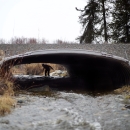States
WashingtonThis project will remove two diversion dams and a non-functional fish screen and replace them with appropriate fish passage fish passage
Fish passage is the ability of fish or other aquatic species to move freely throughout their life to find food, reproduce, and complete their natural migration cycles. Millions of barriers to fish passage across the country are fragmenting habitat and leading to species declines. The U.S. Fish and Wildlife Service's National Fish Passage Program is working to reconnect watersheds to benefit both wildlife and people.
Learn more about fish passage structures on the Toppenish Creek in Washington. Removing these barriers will provide a clearer migration path to spawning habitats for Pacific lamprey and threatened steelhead. In addition to the benefits for fish species, this project will restore and enhance more than 450 acres of wetland habitat on the floodplain of Toppenish Creek. These floodplain wetlands are invaluable wildlife habitat for both migratory and resident species. Toppenish Creek is culturally significant to the Yakama Nation and the area serves as an educational site to retain tribal culture. Yakama Tribal members also hunt on the properties, and gather traditional foods and materials such as Wapato, tule, currants and chokecherries, and willow and dogwood.
Project Quick Facts:
| Project Status | In Development |
| Location | WA, Yakima County |
| NFPP Project Funding | $1,615,400 |
| Restoration Techniques | Fish Screen Installment |
| Accomplishments | 100 Stream Miles Reopened, 5 Acres Reopened |
| Partner Project Lead | Yakama Nation |
The National Fish Passage Program combines technical expertise with a track record of success.
Implemented primarily through the Service's Fish and Wildlife Conservation Offices, the National Fish Passage Program provides financial and technical assistance to partners across the country. Since 1999, the program has worked with over 2,000 local communities, Tribes, and private landowners to remove or bypass over 3,400 barriers to fish passage and reopen access to over 61,000 miles of upstream habitat for fish and other animals. Staff have expertise in fish migration and biology as well as financial, engineering, and planning assistance to communities, Tribes, and landowners to help them remove barriers and restore rivers for the benefit both fish and people.
Fish passage project proposals can be initiated by any individual, organization, government, or agency. However, proposals must be submitted and completed in cooperation with a Fish and Wildlife Conservation Office. (Please note that fish passage projects being used for federal or state compensatory mitigation or required by existing federal or state regulatory programs are not eligible for funding through the National Fish Passage Program.)
CONTACT A FISH PASSAGE COORDINATOR IN YOUR AREA TO GET STARTED.


